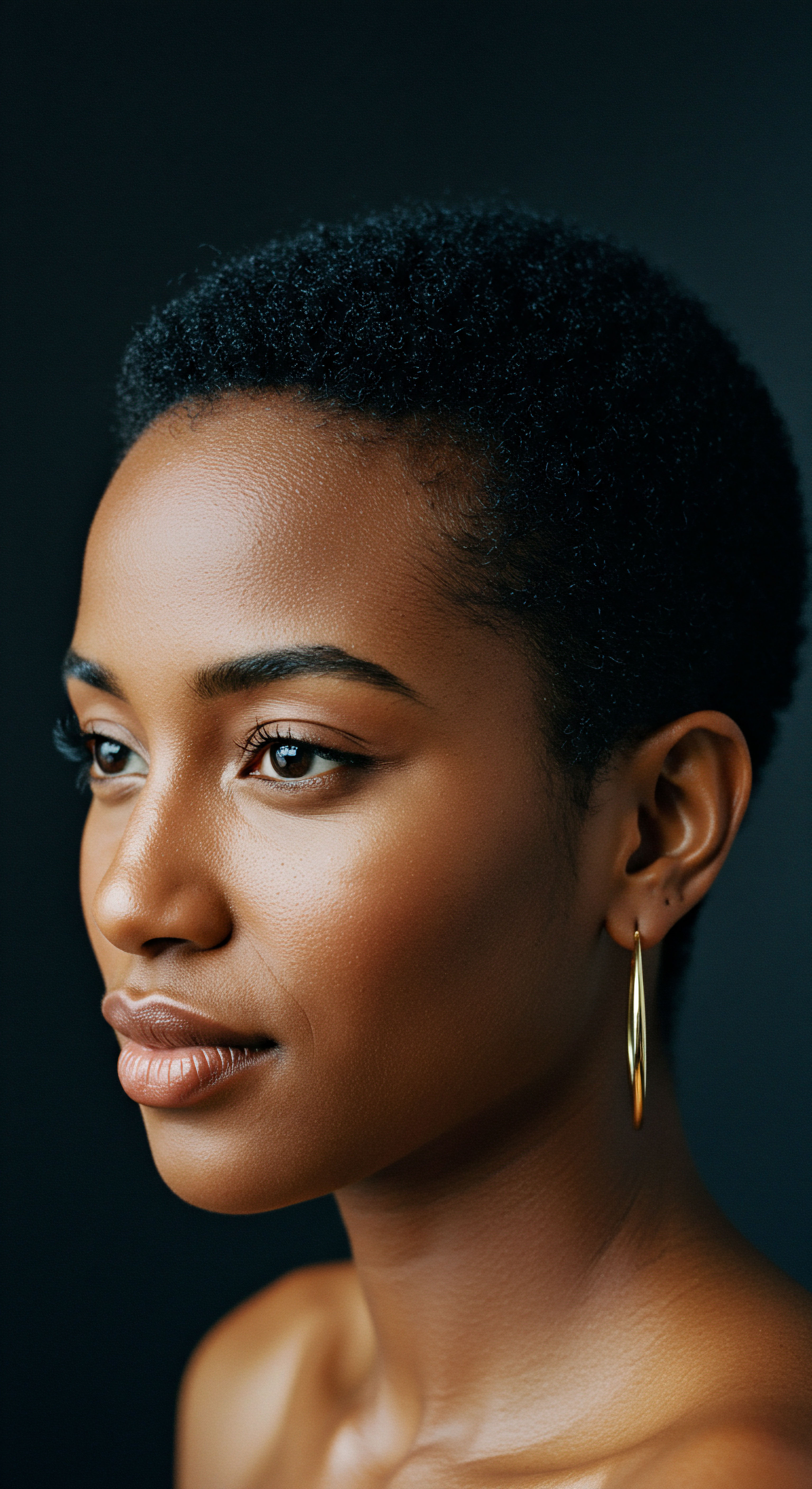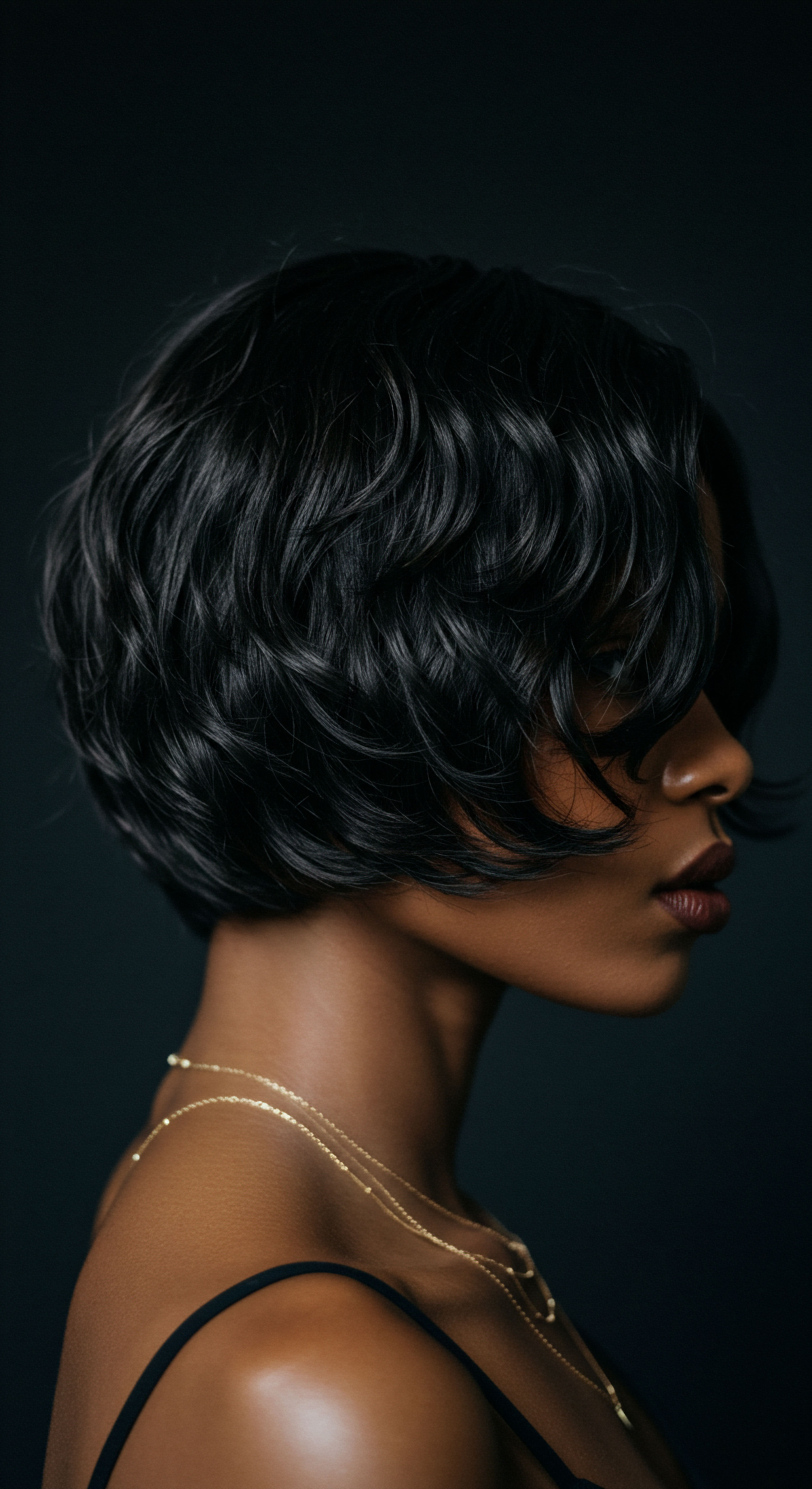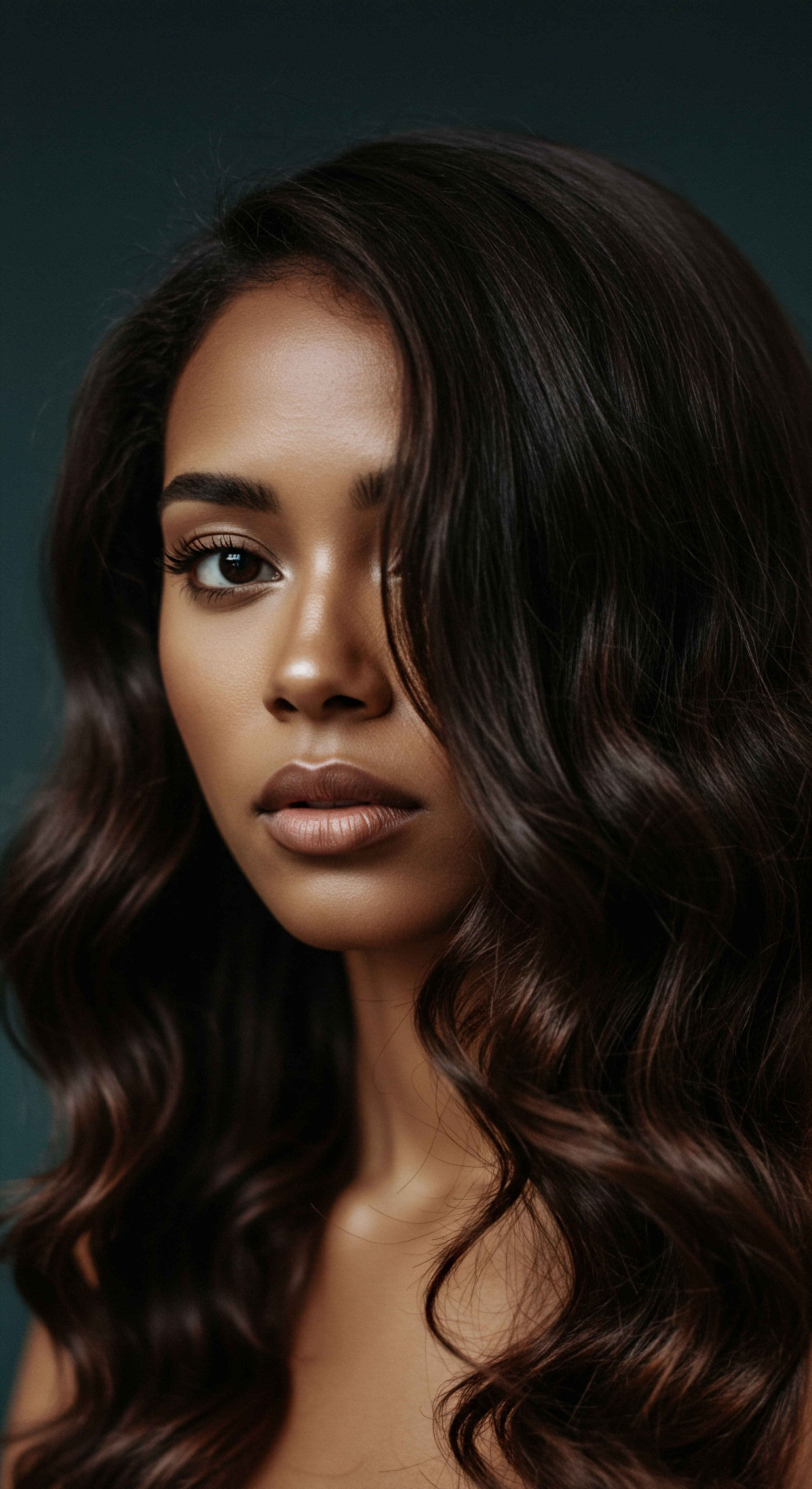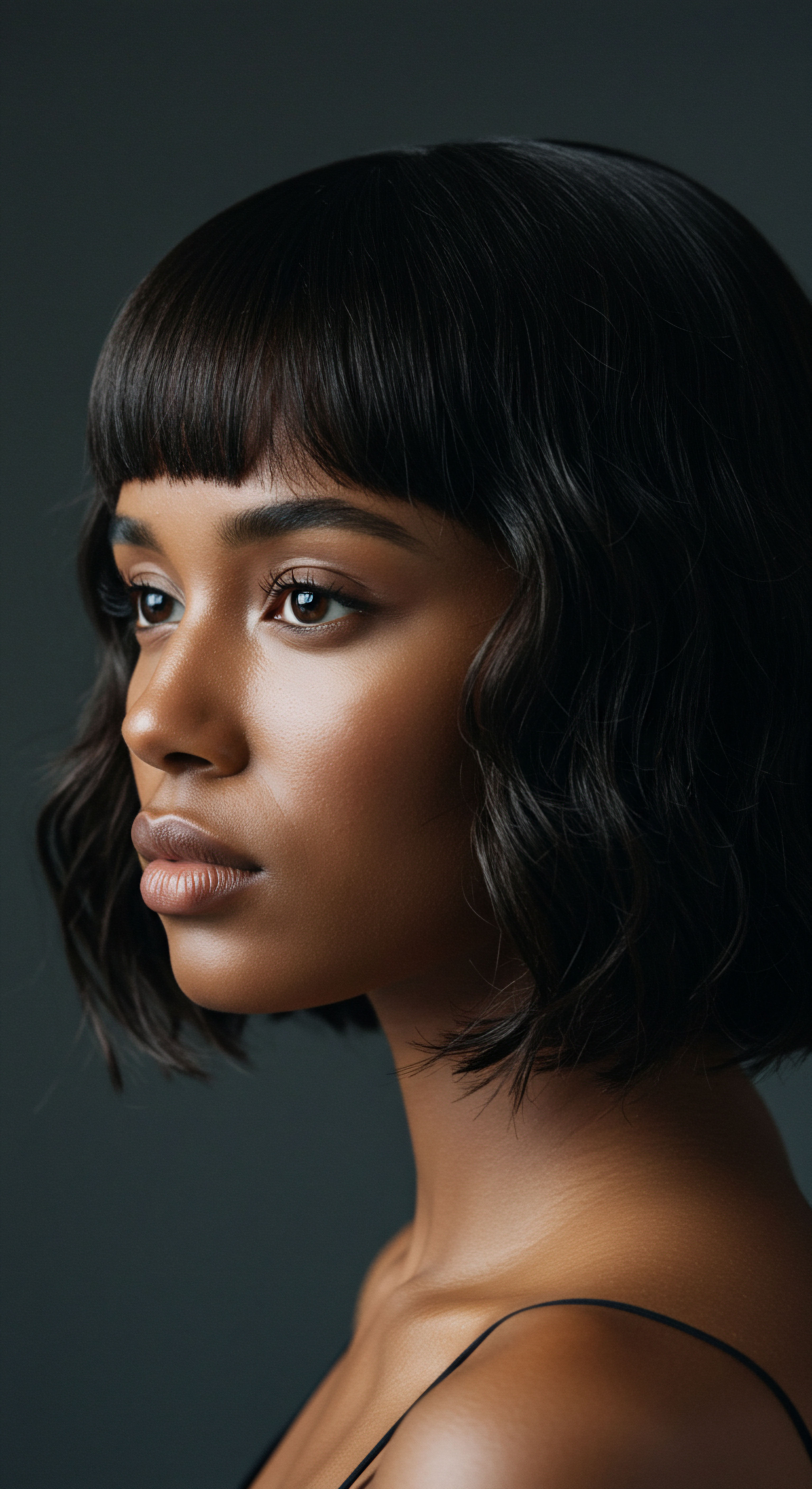
Roots
Consider for a moment the quiet conversation your hair holds with the world, a silent dialogue of texture, resilience, and sometimes, a whisper of thirst. For those graced with the spirited coils and curls that defy straight lines, the perception of dryness often feels like a constant companion. It is a feeling many have come to accept as an inherent characteristic, yet beneath this common experience lies a fascinating, intricate world.
We seek to understand the very foundations of this sensation, peeling back the layers of popular belief to reveal the biological truths held within each strand. What if the feeling of parched curls could be illuminated not just by external conditions, but by the very architectural secrets hidden within your hair’s outermost shield?
Hair, far from being a simple filament, is a marvel of biological engineering. At its core, it is primarily protein, yet a smaller, equally vital component often goes unnoticed ❉ lipids. These fatty substances, accounting for a modest 1-9% of hair’s dry weight, are quietly responsible for much of its strength, luster, and its capacity to retain precious moisture. They are the unsung protectors, guarding the hair fiber against the ceaseless challenges of daily life and environmental exposure.
The outermost guard of the hair shaft, the cuticle, is a fortress of overlapping, scale-like cells. Between these protective scales, and even within the deeper cortical layers, reside these lipids, forming crucial barriers and contributing to the fiber’s physical attributes.

The Cuticle’s Lipid Shield
The cuticle, that shimmering outer layer of your hair, functions as a natural shield, composed of several layers of flat, overlapping cells. Within this structure, particularly on its surface, lies a delicate, yet immensely important, lipid layer. A key player in this lipid composition is 18-Methyleicosanoic Acid (18-MEA). This unique fatty acid is not merely resting on the surface; it is covalently bonded to the outermost protein layer of the cuticle, forming a protective monolayer.
This arrangement gives hair its natural hydrophobicity, a water-repelling quality that helps regulate how much water the hair absorbs from its surroundings. When this layer is intact, hair feels soft, possesses a natural glide, and exhibits a healthy sheen. It also plays a significant part in reducing tangling, especially when hair is wet, by helping strands lie parallel and smoothly aligned.
Beyond 18-MEA, other lipids such as free fatty acids, cholesterol, ceramides, and cholesterol sulfate also populate the hair fiber. These lipids are categorized based on their origin ❉ Exogenous Lipids come from the sebaceous glands, while Endogenous Lipids are produced within the hair matrix cells. All these lipids work in concert to maintain the hair’s integrity and protect it from harm. The presence and arrangement of these lipids are fundamental to the hair’s ability to defend itself against external elements and maintain its healthy state.
The hair cuticle’s lipid content, particularly 18-MEA, acts as a subtle yet powerful shield, regulating moisture and contributing to hair’s natural feel and appearance.

Hair Anatomy and Its Microscopic Details
To truly appreciate the lipid layer, one must consider the entire hair shaft’s architecture. Each strand begins its journey within the follicle, a living structure nestled in the scalp. The visible portion, the hair shaft, is composed of three primary layers ❉ the medulla (present in coarser hair types), the cortex (the bulk of the hair, giving it strength and color), and the cuticle.
The cuticle’s scales overlap like shingles on a roof, and between these scales, the Cell Membrane Complex (CMC) acts as a kind of biological cement. This CMC is not just a structural adhesive; it is also rich in lipids, including 18-MEA, which is crucial for its function.
The distinct structure of curly hair, with its inherent twists and turns, affects how these layers interact and how lipids are distributed. The spiral shape of the hair follicle itself dictates the curl pattern, creating a fiber that is not uniform along its length. This non-uniformity influences how natural oils, which contain exogenous lipids, travel down the hair shaft. For curly hair, this journey is often more challenging, leading to an uneven distribution of these protective oils and contributing to the perception of dryness.

Can Different Hair Types Show Different Lipid Content?
Intriguing research has shown variations in lipid content and organization across different hair types. Studies comparing African, Caucasian, and Asian hair have revealed distinct lipid profiles. For instance, African hair has been observed to possess the highest overall lipid content, estimated to be 2.5 to 3.2 times higher than European and Asian hair, respectively.
Despite this higher lipid presence, Afro-textured hair is frequently described as dry. This apparent contradiction points to the critical role of not just the quantity of lipids, but also their arrangement and the hair’s unique structural properties.
Conversely, Caucasian hair, while having a lower overall lipid content (around 3%), often displays a more ordered lipid structure within its cuticle. This ordered arrangement may contribute to its higher resistance to water absorption and its tendency to remain more hydrated. Asian hair, with the lowest overall lipid content (around 2%), also exhibits distinct lipid characteristics. These findings underscore that the perception of dryness in curly hair is not a simple matter of lipid scarcity, but rather a complex interplay of lipid quantity, organization, and the inherent biomechanics of the hair fiber.
The following table summarizes the approximate lipid content across different hair types, based on research:
| Hair Type African Hair |
| Approximate Lipid Content (Dry Weight) 6% |
| Hair Type Caucasian Hair |
| Approximate Lipid Content (Dry Weight) 3% |
| Hair Type Asian Hair |
| Approximate Lipid Content (Dry Weight) 2% |
| Hair Type These values represent general averages and can vary based on individual factors. |
The variations in lipid content and organization among hair types present a fascinating area of study, hinting at a deeper understanding of hair’s intrinsic properties and its responses to environmental factors. The way lipids are structured and distributed plays a significant part in the hair’s capacity to manage water, influencing how hydrated it appears and feels.

Ritual
Stepping into the daily rhythms of hair care, we acknowledge a desire for methods that truly resonate with the unique needs of curly hair. The practices we adopt, from the gentle cleanse to the conditioning embrace, are not merely routines; they are rituals that profoundly influence the delicate balance of the hair cuticle’s lipid content. How often do we consider the silent effects of our choices on those microscopic protectors? This section seeks to illuminate the practical wisdom behind thoughtful hair care, exploring how our actions can either preserve or diminish the very elements that keep curls supple and vibrant.
The lipid layer of the hair cuticle, particularly the 18-MEA, is susceptible to external influences. Daily handling, washing, and chemical treatments can strip away these vital components, leading to increased porosity and a feeling of dryness. When this protective lipid barrier is compromised, hair becomes more receptive to water, absorbing too much, which can lead to frizz and even physical damage as the hair swells and contracts. The aim of our care practices, then, extends beyond mere cleansing or styling; it becomes about preserving and, where possible, replenishing this crucial lipid shield.

Cleansing and Lipid Preservation
The act of cleansing, while essential for scalp health and removing build-up, can inadvertently impact the hair’s lipid layers. Shampoos contain surfactants, agents designed to lift dirt and oils. While these are necessary, studies suggest that even a single shampooing can remove a significant portion of the hair’s extractable lipids, with repeated washing leading to even greater loss. This loss primarily affects the free lipids on the hair surface, though some structural lipids may also be affected over time.
To mitigate this, selecting cleansers formulated with gentler surfactants or incorporating co-washing (conditioner-only washing) into a routine can be beneficial for curly hair. These approaches aim to cleanse without excessively stripping the hair’s natural oils and its lipid barrier. Following cleansing with a conditioner is also a recognized strategy, as conditioning agents can adsorb to the hair surface, forming a protective layer that helps compensate for lipid loss and reduces friction.
- Gentle Cleansing ❉ Opt for sulfate-free shampoos or co-washes to preserve the hair’s natural lipid layer.
- Conditioning Importance ❉ Apply conditioner after cleansing to help replenish surface lipids and reduce friction.
- Water Temperature ❉ Cooler water can help minimize cuticle lifting and subsequent lipid loss during washing.

Styling Practices and Lipid Integrity
The way we style our hair also influences the integrity of the cuticle’s lipid content. Mechanical friction from brushing, combing, and even vigorous towel-drying can cause physical damage to the cuticle scales, leading to a loss of lipids and an increase in hair’s susceptibility to damage. For curly hair, which is already prone to tangling due to its helical structure, careful detangling is paramount.
Heat styling, such as blow-drying or using flat irons, presents another challenge. High temperatures can denature proteins and disrupt the lipid layers, causing a significant reduction in 18-MEA and making the hair more hydrophilic. The absence of 18-MEA results in hair that feels rough, tangles easily, and loses its natural luster. Employing heat protectants, which often contain silicones or other film-forming agents, can provide a temporary barrier against thermal damage, helping to shield the cuticle and its precious lipids.
Thoughtful hair care rituals, from gentle cleansing to protective styling, directly influence the preservation of the hair cuticle’s lipid content, a silent guardian against dryness.

Can Nighttime Care Significantly Protect Hair Lipids?
Nighttime care often goes overlooked, yet it presents a golden opportunity to shield hair lipids from daily wear. The friction between hair strands and bedding materials, especially cotton, can lead to cuticle abrasion and subsequent lipid loss. Cotton, with its absorbent nature, can also draw moisture from the hair, exacerbating dryness. This is where the wisdom of protective nighttime rituals truly shines.
Sleeping on a Satin or Silk Pillowcase or using a Satin or Silk Bonnet creates a smoother surface for hair to glide over, significantly reducing friction. This simple change helps preserve the cuticle’s integrity, minimizing mechanical damage and the stripping of surface lipids. Additionally, these materials are less absorbent than cotton, allowing hair to retain its moisture and natural oils throughout the night. For many with textured hair, this practice is not just a comfort but a cornerstone of maintaining hair health and mitigating dryness.
Consider a case study demonstrating the protective benefits of silk ❉ In a comparative analysis, hair strands exposed to friction from cotton pillowcases showed increased cuticle lifting and a greater reduction in surface lipids compared to strands exposed to silk. This suggests that the smoother surface of silk helps to maintain the integrity of the hair’s outer layer, thereby preserving its lipid content and contributing to improved moisture retention and reduced dryness over time.
The following table outlines the benefits of various nighttime hair protection methods:
| Method Satin/Silk Pillowcase |
| Primary Benefit for Lipids Reduces friction, preserving cuticle lipids |
| Additional Benefits Minimizes tangles, retains moisture, reduces frizz |
| Method Satin/Silk Bonnet |
| Primary Benefit for Lipids Encloses hair, offering all-around lipid protection |
| Additional Benefits Prevents breakage, maintains style, retains moisture |
| Method Loose Braids/Twists |
| Primary Benefit for Lipids Minimizes inter-strand friction, protects ends |
| Additional Benefits Prevents tangling, maintains curl pattern, reduces manipulation |
| Method These methods collectively contribute to a healthier hair environment, supporting lipid integrity. |
Incorporating these gentle practices into a regular routine can significantly contribute to the long-term health of textured hair, helping to maintain the precious lipid barrier that plays such a central part in preventing dryness. It is a testament to how small, consistent acts of care can yield substantial benefits for hair’s overall well-being.

Relay
We turn now to a more expansive view, one that connects the microscopic world of the hair cuticle to broader currents of scientific inquiry, cultural practice, and even genetic predispositions. The question of whether hair cuticle lipid content explains dryness in curly hair is far more complex than a simple yes or no. It invites us to consider the intricate dance between our biology, our environment, and the legacies of our heritage.
What hidden messages do our strands carry about their lipid composition, and how do these messages translate into the daily experience of dryness? This exploration delves into the less apparent complexities, drawing from research and observations that challenge common assumptions and deepen our collective understanding.

The Paradox of Lipid Content and Dryness in Textured Hair
A particularly compelling area of research reveals what might seem a paradox ❉ Afro-textured hair, often characterized by dryness, has been shown to possess a higher overall lipid content compared to European or Asian hair. This finding, supported by studies utilizing techniques like Fourier transform infrared synchrotron spectroscopy, indicates that African hair can have up to 6% lipid content, while Caucasian hair typically has 3% and Asian hair around 2%.
If more lipids are present, why the persistent dryness? The answer appears to lie not merely in the quantity of lipids, but in their organization and distribution, alongside the unique biomechanical properties of curly hair. Research suggests that lipids in African hair are often more disordered compared to the more ordered lipid arrangements found in Caucasian hair. This disordered structure, despite higher lipid levels, may contribute to increased water diffusion and permeability.
African hair, despite having higher lipid content, often experiences dryness due to a more disordered lipid arrangement and its unique structural properties.
The very structure of curly hair, with its elliptical cross-section and numerous twists and turns, creates areas of weakness and makes it more susceptible to breakage. These structural characteristics also hinder the efficient travel of natural sebaceous oils from the scalp down the hair shaft, leading to uneven lubrication and localized dryness along the length of the strand. Therefore, while lipids are present in abundance, their effectiveness as a moisture barrier is influenced by their chaotic arrangement and the hair’s intrinsic architecture.

Beyond 18-MEA ❉ The Spectrum of Hair Lipids
While 18-MEA holds a prominent position in discussions of hair surface integrity, it is but one component of a broader lipid spectrum. Hair lipids also include free fatty acids, cholesterol, ceramides, and glycosylceramides. Each of these plays a part in the hair’s barrier function and overall health. For instance, ceramides are crucial for maintaining the integrity of the cell membrane complex within the cuticle, acting as a binder between cells.
The interplay of these various lipid types, their concentrations, and their structural organization is a complex biological puzzle. Environmental factors, such as UV radiation, can decrease lipid content, particularly free fatty acids and cholesterol. Chemical treatments like bleaching and coloring are known to significantly deplete 18-MEA and other surface lipids, leading to a hydrophilic surface that readily absorbs water but struggles to retain it. This transformation from a water-repelling (hydrophobic) to a water-absorbing (hydrophilic) surface is a direct contributor to the feeling of dryness and increased friction.

The Impact of Lipid Loss and Restoration
The loss of hair lipids, whether through daily wear or chemical processes, has measurable consequences. Studies have shown that a decrease in hair lipid content correlates with reduced tensile strength and increased hair breakage. This means that hair lacking its protective lipid shield is not only prone to feeling dry but is also physically weaker and more vulnerable to mechanical stress. The tensile properties of hair, including its strength and elasticity, tend to decline from root to tip, mirroring the progressive loss of lipids like 18-MEA along the hair shaft due to grooming and environmental stressors.
Can these lost lipids be truly restored? While covalently bound 18-MEA, once removed, cannot be perfectly duplicated or reattached in its natural form, cosmetic science has made strides in developing formulations that can deposit modified versions of 18-MEA or other lipid-like compounds onto the hair surface. These products aim to mimic the protective and lubricating properties of natural lipids, helping to restore hydrophobicity, reduce tangling, and enhance shine.
For example, treatments containing ingredients like shea butter are being explored for their capacity to help retain and replenish 18-MEA, working from the fiber surface to deeper cortical layers. One such example is a “Shea Collagen Therapy” which claims to penetrate deeply to restore 18-MEA levels, unlike typical spa treatments.
Consider a study where hair samples treated with a specialized serum designed to restore the lipid layer showed a 72% restoration of damaged hair in a single application compared to a placebo. This effect, attributed to compounds that reinforce cuticle hydration and provide protection, was observed to persist even after rinsing, maintaining a 65% recovery rate. Such findings underscore the potential for targeted cosmetic interventions to address lipid deficiencies and improve hair’s resilience.
The implications extend to the development of tailored hair care solutions. Understanding the precise lipid deficiencies and the structural challenges of specific hair types allows for the creation of products that genuinely address the root causes of dryness, rather than simply masking symptoms. This scientific approach helps shift the conversation from a blanket assumption of dryness to a more nuanced understanding of lipid dynamics within the hair fiber.
The complex interplay between lipid content, its organization, and the inherent physical properties of curly hair provides a more complete picture of why dryness is such a prevalent concern. It suggests that effective care must go beyond surface-level treatments, aiming to support the hair’s intrinsic protective mechanisms.

Reflection
Our exploration into the hair cuticle’s lipid content and its connection to dryness in curly hair reveals a world far richer than simple surface observations. It is a landscape where biology, chemistry, and cultural practices intersect, painting a picture of intricate balance and surprising resilience. We have seen that the perception of dryness in textured hair is not a singular phenomenon but a complex interplay of inherent structure, the integrity of the cuticle’s lipid shield, and the impact of our daily interactions with our strands.
The story of 18-MEA, and indeed the broader spectrum of hair lipids, speaks to the profound influence of these microscopic components on the macroscopic experience of our hair. To truly understand and nurture textured hair is to appreciate these hidden mechanisms, moving beyond generalized notions to embrace a more informed, gentle, and deeply respectful approach to its care.

References
- Robbins, C. R. (2012). Chemical and Physical Behavior of Human Hair. Springer Science & Business Media.
- Franbourg, A. Hallegot, P. Baltenneck, F. Freyssinet, J. M. & Bouillon, C. (2003). Current research on ethnic hair. Journal of the American Academy of Dermatology, 48(6), S115-S119.
- Coderch, L. Méndez, S. Barba, C. de la Maza, A. & Parra, J. L. (2021). The influence of hair lipids in ethnic hair properties. Cosmetics, 8(4), 107.
- Gambichler, T. & Boms, S. (2017). Hair. In Cosmetics (pp. 1-18). Springer, Cham.
- Koch, R. (1982). Hair and Hair Care. Parfumerie und Kosmetik, 63(3), 112-116.
- Syed, A. N. Kazi, S. H. & Naqvi, S. A. H. (2006). Hair structure and the effect of cosmetic products. In Cosmetic Science and Technology (pp. 209-224). CRC Press.
- Gould, D. H. & Sneath, P. H. A. (1984). Damage to human hair by shampoos. Journal of the Society of Cosmetic Chemists, 35(6), 335-345.
- Tate, J. M. Speight, J. G. & Smith, G. (1993). The effects of conditioners on the surface properties of hair. Journal of the Society of Cosmetic Chemists, 44(6), 319-328.
- Hotta, T. Minami, K. Kawamura, Y. Tsuboi, T. & Takehara, K. (2012). Quantification of 18-methyleicosanoic acid in human hair by liquid chromatography/mass spectrometry. Journal of Cosmetic Science, 63(1), 1-9.
- Popescu, C. & Hillebrand, S. (2004). The effect of UV radiation on hair and photoprotection. Journal of Photochemistry and Photobiology B ❉ Biology, 74(1), 1-10.
- Robbins, C. R. (2011). Chemical and Physical Behavior of Human Hair (5th ed.). Springer.
- Miyamoto, A. & Imokawa, G. (2004). Quantitative analysis of 18-methyleicosanoic acid in human hair by gas chromatography/mass spectrometry. Journal of Cosmetic Science, 55(1), 1-12.
- Su, Q. Zhou, C. He, C. Jiao, Q. Wang, Z. & Jia, Y. (2023). Research Progress in Composition, Classification and Influencing Factors of Hair. American Journal of Biomedical Science & Research, 20(3).
- Coderch, L. Barba, C. & Parra, J. L. (2017). Hair lipids ❉ a review. Journal of Cosmetic Science, 68(1), 1-10.
- Sakamoto, H. & Imokawa, G. (2007). Effect of 18-methyleicosanoic acid on the surface properties of human hair. Journal of Cosmetic Science, 58(4), 361-372.